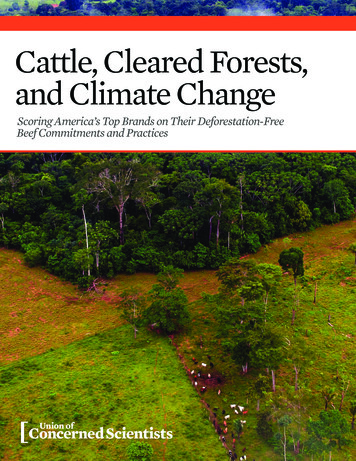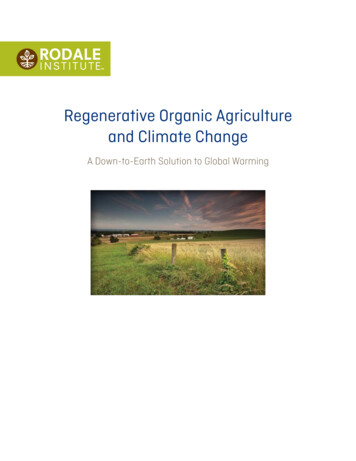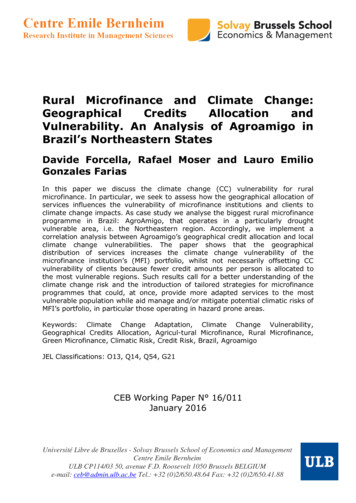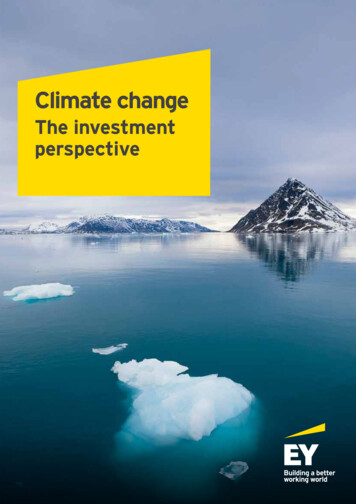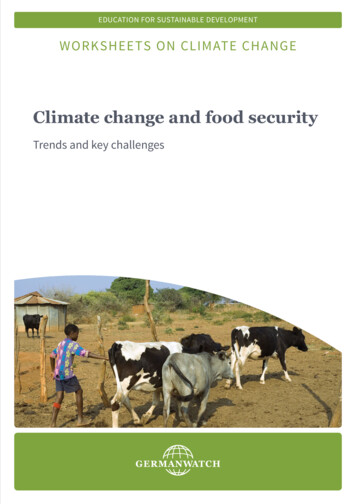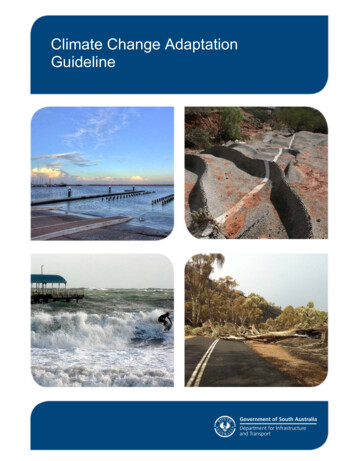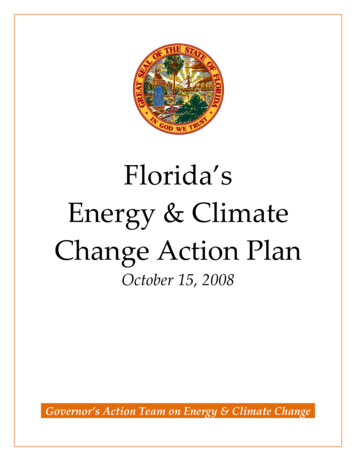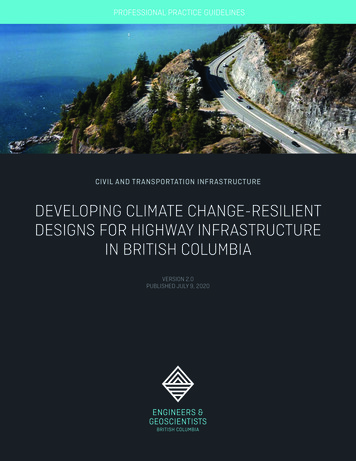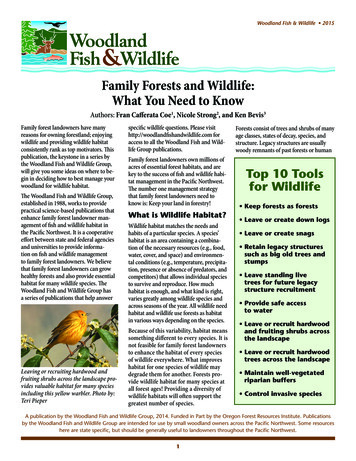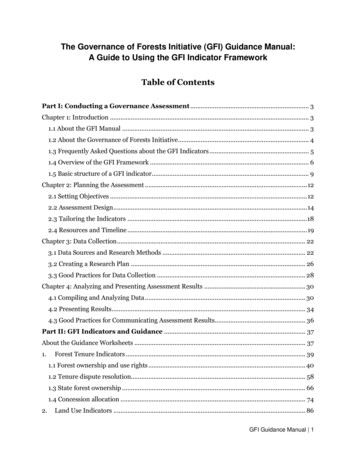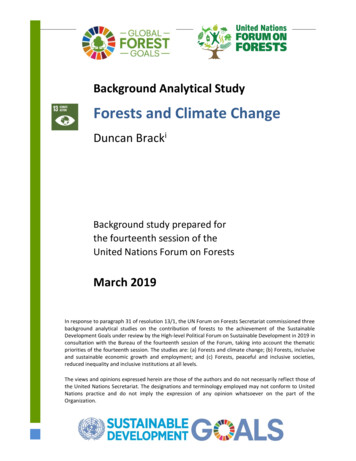
Transcription
Background Analytical StudyForests and Climate ChangeDuncan BrackiBackground study prepared forthe fourteenth session of theUnited Nations Forum on ForestsMarch 2019In response to paragraph 31 of resolution 13/1, the UN Forum on Forests Secretariat commissioned threebackground analytical studies on the contribution of forests to the achievement of the SustainableDevelopment Goals under review by the High-level Political Forum on Sustainable Development in 2019 inconsultation with the Bureau of the fourteenth session of the Forum, taking into account the thematicpriorities of the fourteenth session. The studies are: (a) Forests and climate change; (b) Forests, inclusiveand sustainable economic growth and employment; and (c) Forests, peaceful and inclusive societies,reduced inequality and inclusive institutions at all levels.The views and opinions expressed herein are those of the authors and do not necessarily reflect those ofthe United Nations Secretariat. The designations and terminology employed may not conform to UnitedNations practice and do not imply the expression of any opinion whatsoever on the part of theOrganization.
Contents1Introduction.32Background: forests and climate change .5345672.1Role of forests and their ecosystem services in climate systems: carbon .52.2Other roles of forests and their ecosystem services in climate systems .112.3Impacts of climate change on forests .12Forests in the climate agreements .183.1Reporting and accounting for forest carbon stocks and emissions .183.2Forests in the Paris Agreement .193.3The climate agreements and the UN Strategic Plan for Forests .21Forests and climate mitigation .234.1Reducing pressures on forests: REDD .274.2Reducing pressures on forests: agricultural commodity supply chain initiatives .294.3Sustainable forest management .324.4Increasing forest cover .354.5Increasing the value of forests: promoting sustainably produced wood products .384.6Wood for energy .40Forests and climate adaptation .445.1Forests for adaptation.445.2Adaptation for forests .46Underlying requirements: finance and governance .486.1Finance .486.2Forest governance .51Conclusions and recommendations .55Forests and SDG13 March 2019Page 2
1 IntroductionThe purpose of this paper is to provide background analysis on the critical role played by healthy andresilient forests in climate change mitigation and adaptation.As the largest storehouse of carbon after the oceans, forests already absorb and store about 30 per centof current levels of carbon emissions from fossil fuels and industry into their biomass, soils and woodproducts, and have the potential to store much more. At present, however, about 12 per cent of globalgreenhouse gas emissions are estimated to derive from deforestation, a process which is itself made moreacute by the impacts of climate change. Forests can also help communities adapt to the impacts of climatechange, stabilising and cooling local climates, including water flow and rainfall.References to climate change occur in several places in the United Nations Strategic Plan for Forests 2017–2030 (UNSPF) agreed by the UN General Assembly in 2017, and its Global Forest Goals (GFGs). The boxbelow reproduces the GFGs which explicitly reference climate change, and those which are directlyrelevant even while they do not mention climate change; the implications are discussed further in Sections4, 5 and 6 (in practice, virtually all the GFGs are of some relevance).UN Strategic Plan for Forests 2017–2030: Global Forest Goals11.Reverse the loss of forest cover worldwide through sustainable forest management, includingprotection, restoration, afforestation and reforestation, and increase efforts to prevent forestdegradation and contribute to the global effort of addressing climate change.1.1 Forest area is increased by 3 per cent worldwide.1.2 The world’s forest carbon stocks are maintained or enhanced.1.3 By 2020, promote the implementation of sustainable management of all types of forests,halt deforestation, restore degraded forests and substantially increase afforestation andreforestation globally.1.4 The resilience and adaptive capacity of all types of forests to natural disasters and the impactof climate change is significantly strengthened worldwide.2.Enhance forest-based economic, social and environmental benefits, including by improving thelivelihoods of forest dependent people. 2.5 The contribution of all types of forests to biodiversity conservation and climate changemitigation and adaptation is enhanced, taking into account the mandates and ongoing workof relevant conventions and instruments.3.Increase significantly the area of protected forests worldwide and other areas of sustainablymanaged forests, as well as the proportion of forest products from sustainably managed forests. 1Resolution adopted by the Economic and Social Council on 20 April 2017: United Nations strategic plan for forests 2017–2030and quadrennial programme of work of the United Nations Forum on Forests for the period 2017–2020 (E/RES/2017/4, July2017).Forests and SDG13 March 2019Page 3
3.3 The proportion of forest products from sustainably managed forests is significantlyincreased.4.Mobilize significantly increased, new and additional financial resources from all sources for theimplementation of sustainable forest management and strengthen scientific and technicalcooperation and partnerships. 5.Promote governance frameworks to implement sustainable forest management, includingthrough the United Nations forest instrument, and enhance the contribution of forests to the2030 Agenda for Sustainable Development. 5.2 Forest law enforcement and governance are enhanced, including through significantlystrengthening national and subnational forest authorities, and illegal logging and associatedtrade are significantly reduced worldwide.The Sustainable Development Goals (SDGs) are also relevant. Agreed by the UN General Assembly in 2015as the core of the 2030 Development Agenda, Transforming our World: the 2030 Agenda for SustainableDevelopment, SDG 13 deals explicitly with climate change (see box).Sustainable Development Goal 13. Take urgent action to combat climate change and its impacts 213.1 Strengthen resilience and adaptive capacity to climate-related hazards and natural disasters in allcountries.13.2 Integrate climate change measures into national policies, strategies and planning.13.3 Improve education, awareness-raising and human and institutional capacity on climate changemitigation, adaptation, impact reduction and early warning.This paper provides an overview of the interaction between forests and climate change. Section 2examines the roles forests play in regulating the global and local climate, the impacts of forests on climatechange and the impacts of climate change on forests. Section 3 analyses the treatment of forests, includingthe measurement of forest-related greenhouse gas emissions and sinks, in the international climateagreements. Section 4 discusses a range of mitigation options: ways in which forests and forest policy canhelp to reduce the rate of climate change. Section 5 discusses adaptation: measures through which forestscan help societies adapt to the impacts of climate change and ways in which forests themselves may needto be assisted to adapt to climate change. Section 6 discusses key requirements underlying the success ofall the measures examined in Sections 4 and 5: the need for financial support and improvements in forestgovernance. Section 7 provides some brief conclusions, in particular on the synergies between the climateagreements and UNSPF and its Global Forest Goals.2Ibid.Forests and SDG13 March 2019Page 4
2 Background: forests and climate change2.1 Role of forests and their ecosystem services in climate systems: carbonForests play a critical role in the Earth’s climate system, in a number of different ways. Most importantlyfor global climate change, they capture carbon dioxide from the atmosphere and convert it, throughphotosynthesis, into living biomass: tree trunks, roots, branches and leaves. Forests also store carbon inforest soils, absorbed through leaf litter, woody debris and roots; whether these inputs are sequesteredin the soil matrix or biodegraded and returned to the atmosphere as carbon dioxide, and if so at what rate,depends on complex interactions involving soil minerals, plants and soil organisms, and organiccomponents, all influenced by factors such as local climatic conditions and forest management.Estimates of the carbon stored in the world’s forests vary significantly. In 2000 the IntergovernmentalPanel on Climate Change (IPCC) estimated a total volume of 1,100 gigatonnes (Gt, or billion tonnes).3 Thisamount is 1.3 times larger than the carbon stored in fossil fuel reserves (estimated at about 800 Gt), andmore than the carbon already added to the atmosphere as a consequence of human activities since 1870(about 600 Gt).4 In 2010 the Food & Agriculture Organisation (FAO) estimated a smaller total carbon stockof 652 Gt of carbon: 44 per cent in live biomass, 5 per cent in dead wood, 6 per cent in litter and 45 percent in the soil.5Another study, published in 2011, using bottom-up estimates of carbon stocks and fluxes based oninventory data and long-term field observations, estimated 861 66 Gt carbon, with a similar breakdown:42 per cent in live biomass, 8 per cent in dead wood, 5 per cent in litter and 44 per cent in soil.6 Accordingto this latter study, geographically, 55 per cent is stored in tropical forests, 32 per cent in boreal forestsand 14 per cent in temperate forests. Tropical and boreal forests are similar in terms of carbon stockdensity (242 and 239 tonnes of carbon per hectare, respectively), whereas temperate forests are about 40per cent lower (155 tonnes / hectare). Although tropical and boreal forests store the most carbon, thebiomass-soil interaction is quite different: in tropical forests 56 per cent of carbon is stored in biomass and32 per cent in soil, whereas in boreal forests, just 20 per cent is stored in biomass and 60 per cent in thesoil.Forests play a role in mitigating climate change by absorbing the carbon dioxide emitted into theatmosphere from human activities, chiefly the burning of fossil fuels for energy and other purposes, intothe terrestrial carbon sink (see Figure 2.1 – biosphere). It has been estimated that since 1750, forests (andother vegetation, but mainly forests) have been responsible for about half of the carbon emissionsnaturally sequestered from the atmosphere; the rest has been absorbed by the oceans.7 Together, forests3Robert T. Watson et al, IPCC Special Report on Land Use, Land-Use Change And Forestry (IPCC, 2000).Sandro Federici, Donna Lee and Martin Herold, Forest Mitigation: A Permanent Contribution to the Paris Agreement (Climateand Land Use Alliance, November 2018).5 FAO, Global Forest Resources Assessment 2010.6 Yude Pan et al., ‘A Large and Persistent Carbon Sink in the World’s Forests’, Science 333, 988 (2011).7 P. Ciais et al., ‘Carbon and Other Biogeochemical Cycles’, in Climate Change 2013: The Physical Science Basis – Contribution ofWorking Group I to the Fifth Assessment Report of the Intergovernmental Panel on Climate Change (Cambridge University Press,2013).4Forests and SDG13 March 2019Page 5
and oceans form a natural buffer against climate change (though increasing concentrations of carbondioxide in seawater gradually acidify the oceans, with negative impacts on marine life).Conversely, deforestation contributes to climate change (see Figure 2.1 – land-use change). When forestsare burned or cleared for uses such as cropland, pasture, infrastructure or urbanisation, the net flow ofcarbon from the atmosphere into the forest ends, both in the present and for the entire projected futurelifetime of the trees. Deforestation also causes the release of the stock of carbon that has accumulated,both in the trees themselves and in the forest soil. The speed of release of the carbon depends on how theforest is cleared and what the wood is used for: clearance by burning or for use as bioenergy causes animmediate, or almost immediate, release of carbon into the atmosphere, whereas harvesting for woodproducts, such as timber for construction, panels, furniture or paper, will trap some of the carbon in theproduct for its lifetime, which ranges from a few years for paper to, potentially, many decades for otherwood products (see further in Section 4.5). Forest biomass left in the forest, such as twigs, branches orstumps left after harvesting, will decay and eventually release its stored carbon into the atmosphere; thisprocess can take years or decades, depending on the type of residue and the local climatic conditions (hotor cold, wet or dry, etc.).Fig 2.1 Schematic representation of the overall perturbation of the global carbon cycle caused byanthropogenic activities, averaged globally for the decade 2008–20178The net impact on the climate also depends on what replaces the cleared forest. If selectively harvestedrather than clear-cut, forest can regenerate naturally; trees can also be replanted through active forestmanagement. More commonly, however, especially in recent decades in the tropics, forest has beencleared completely, particularly for agriculture (confirmed by several recent studies as the main globaldriver of deforestation) for both domestic consumption and export markets, and also for mining,infrastructure development and urban expansion. A 2018 study identified the five drivers most stronglyassociated with gross global tree cover loss over the period 2001–15:9 89Commodity-driven deforestation (27 per cent) – permanent conversion of forest for the expansionof commodities such as palm oil, soy, beef, minerals and oil and gas. These areas are not likely tobe reforested.Source: Corinne Le Quéré et al, ‘Global carbon budget 2018’, Earth System Science Data 10 (2018).Philip G. Curtis et al, ‘Classifying drivers of global forest loss’, Science 361:6407 (2018).Forests and SDG13 March 2019Page 6
Forestry (26 per cent) – loss within managed forests and tree plantations, which are expected toregrow after harvest. Shifting agriculture (24 per cent) – loss, primarily in tropical regions, through clearance and burningfor short-term cultivation of subsistence crops. These forests may or may not grow back,depending on the cultivation practices. Wildfires (23 per cent) – loss from fires; trees are likely to regenerate gradually over time. Overthis period (2001–15) this loss was concentrated in the northern forests of Canada and Russia. Urbanisation (0.6 per cent) – loss from urban expansion; considered permanent, concentratedmainly in the eastern United States.The impact of deforestation on the climate also varies with the type of forest.10 Self-evidently, clearanceof tall, dense forests produces more carbon emissions per unit of land area than clearing low, sparseforests. Deforestation has a particularly severe impact when it takes place on carbon-rich peat soil. Peatswamps contain up to 2,000 tonnes of carbon per hectare, an order of magnitude greater than tropicalforests. When stripped of their protective forest cover and drained of water, previously inundated peatsoil is left exposed above the water table, where it oxidizes and decays, releasing carbon into theatmosphere. It also becomes highly flammable; clearance of peat forests creates a high chance of fires thatcan last for decades. Peatlands cover just 3 per cent of global land area, but store 20–25 per cent of all soilcarbon. There is a similar story with mangrove forests, which store an average of 1,000 tonnes of carbonper hectare in their soils, and are currently being cleared faster than tropical forests, for shrimp farms,tourism and other uses.Forest degradation – as opposed to full deforestation – also affects climate change. In forests that are leftstanding, logging, wood fuel extraction, fires and grazing typically reduce carbon stocks faster than theycan naturally recover. Although the data is uncertain, a 2015 study suggested that emissions from forestdegradation were a quarter of those from deforestation in the decade 2001–10, increasing to one third ofthose from deforestation in the period 2011–15, with substantial variation across countries.11 As well ascausing climate change, forest degradation can be a precursor to outright deforestation: the constructionof roads for logging or mining activities, for example, makes it easier for people to gain access to forestsand subsequently convert them completely to agriculture.Scale of impacts of forest growth and deforestation on climate changeThe impact of forests on atmospheric concentrations of carbon dioxide will be the net outcome of thecarbon absorbed by forest growth (the carbon sink) and the carbon emitted from deforestation and forestdegradation (emissions). Figure 2.2 shows estimates for the period since 1900: forests account for most ofthe land-use change emissions (yellow) and almost all of the land sink (green). The growth in net emissionsinto the atmosphere (light blue), causing global warming, can be clearly seen.10All figures in this paragraph: Frances Seymour and Jonah Busch, Why Forests? Why Now? The Science, Economics, and Politicsof Tropical Forests and Climate Change (Center for Global Development, 2016).11 Sandro Federici et al, ‘New estimates of CO2 forest emissions and removals: 1990–2015’, Forest Ecology and Management352 (2015).Forests and SDG13 March 2019Page 7
Table 2.3 provides estimated figures for the different components since the 1960s, based on a review ofrecent studies. In 2017 forests absorbed an estimated 3.8 billion tonnes of carbon, about 38 per cent ofemissions from fossil fuel use and industry. At the same time, land-use change accounted for 12 per centof total climate-forcing emissions. The equivalent figures for the decade to 2017 were 30 per cent and 14per cent.Fig 2.2 Graphical representation of the global carbon budget as illustrated in Figure 2.112Table 2.3 Decadal mean in the five components of the anthropogenic carbon budget13Note that this figure contains figures for carbon, not carbon dioxide, unlike Figures 2.1 and 2.2. One Gt carbon 3.664Gt carbon dioxide.1213Source: Le Quéré et al, ‘Global carbon budget 2018’.Source: ibid.Forests and SDG13 March 2019Page 8
As can be seen, emissions from land use change, including forestry, have remained roughly constant overthe period since 1960: deforestation in the tropics has been largely counteracted by growth in boreal andtemperate regions (see further below). The annual terrestrial carbon sink has grown, though this has beensubject to considerable variability, particularly during El Niño events, which cause a significant reduction.Figure 2.4 shows the net outcome of sink and emissions.Fig 2.4 Terrestrial carbon sink, 1960–201714A more detailed analysis of the average annual change in the carbon stock of established forests, and theannual average emissions from deforestation and forest degradation (using data from 1990–99 and 2000–07) showed important regional differences (see Figure 2.5), as well as confirming that non-forestecosystems were neither a major source nor a major sink over these two periods.151415Source: ibid.Pan et al., ‘A Large and Persistent Carbon Sink in the World’s Forests’.Forests and SDG13 March 2019Page 9
Fig 2.5 Carbon sinks and sources (Gt carbon per year) in the world’s forests, 1990–2007Coloured bars in the downward-facing direction represent carbon sinks, whereas bars in the upward-facing directionrepresent carbon sources (emissions). Light and dark purple global established forests (boreal, temperate, and intacttropical forests); light and dark green tropical regrowth forests after anthropogenic disturbances; and light and darkbrown tropical gross deforestation emissions. Note these are figures for carbon, not carbon dioxide.Boreal forests, on average, showed little difference between the two time periods, but this maskedsignificant changes within the region: increases in forest cover in European Russia and northern Europecounteracted a sharp fall in Canadian managed forests, mostly due to intensified wildfires and insectoutbreaks. The carbon sink in temperate forests increased by 17 per cent in 2000–07 compared to 1990–99, due in particular to forest growth in the United States (slightly offset by higher drought stress andincreased mortality from insects and fires in the western US) and China, where the biomass sink almostdoubled thanks to an intensive national afforestation and reforestation programme.In contrast, the tropical forest carbon sink uptake fell by 23 per cent between the two time periods in thestudy as a result of deforestation reducing intact forest area, together with a severe drought in the Amazonregion in 2005. This was partly offset by an increase in the carbon sink in tropical regrowth, i.e. forestsrecovering from deforestation, logging, or abandoned agriculture, which represented about 30 per cent ofthe total tropical forest area. The combined tropical forest area, both intact and regrowth, on averageaccounted for about 70 per cent of the gross carbon sink in the world’s forests (about 4.0 Gt carbon peryear). However, given the equally significant gross emissions from tropical deforestation, tropical forestswere in effect nearly carbon-neutral. The net global increase in the forest carbon sink resides mainly intemperate and boreal forests.It should be noted that all these estimates are subject to considerable uncertainty and data gaps. Thereare also significant differences between data reported from independent studies and national greenhousegas emission reports. The most recent IPCC report estimated net land-use emissions (most of which arefrom forests) for 2000–09 as about 1.09 Gt of carbon per year, whereas countries collectively reported netForests and SDG13 March 2019Page 10
emissions closer to 0.25 Gt carbon.16 There are several reasons for this anomaly, including differencesbetween all changes in forest carbon fluxes, including both natural and anthropogenic changes (which iswhat the IPCC reports cover) and anthropogenic changes only (i.e. fluxes from managed forest, whichshould be the only ones included in national reports); a lack of capacity to conduct detailed measurements;differences in data sets and definitions; and the complexity of attempting to measure carbon stocks inabove and below-ground biomass, deadwood, litter, soil etc.2.2 Other roles of forests and their ecosystem services in climate systemsForests affect climate systems in many other ways than carbon storage. In particular, forests playimportant roles in producing and regulating the world’s temperatures and fresh water flows. Indeed, onepaper published in 2017 argued that carbon sequestration should be seen merely ‘as one co-benefit ofreforestation strategies designed to protect and intensify the hydrologic cycle and associated cooling’.17Forests contribute to atmospheric moisture and rainfall patterns over land through evapotranspiration:evaporation from soil and plant surfaces and transpiration of water by plants.18 On average, at least 40 percent of rainfall over land originates from evapotranspiration. The resulting atmospheric moisture iscirculated by winds across the Earth’s continents and oceans. This cross-continental production andtransport of atmospheric moisture – ‘precipitation recycling’ – can promote and intensify theredistribution of water across terrestrial surfaces.Forest loss and degradation reduce evapotranspiration, with implications for rainfall thousands ofkilometres downwind. In addition, by affecting the Earth’s surface albedo, temperature, and surfaceroughness, forests alter moisture and heat fluxes between terrestrial surfaces and the atmosphere. Treesand forests also lead to more intense rainfall through the biological particles (fungal spores, pollen,bacterial cells and biological debris) they release into the atmosphere, which accelerates condensation ofatmospheric moisture. Climate modellers have predicted that large-scale deforestation may reduce rainfallin some regions by as much as 30 per cent, and this can lead to feedback effects including slower forestgrowth, drought, die-off and fires.Large, continuous areas of forest drive the atmospheric circulation that brings rainfall to continentalinteriors, according to the ‘biotic pump’ theory first postulated in 2007. Under this theory, throughtranspiration and condensation forests actively create low-pressure regions that draw in moist air fromthe oceans, generating prevailing winds capable of carrying moisture and sustaining rainfall far withincontinents. Deforestation may therefore cause significant changes in wind patterns and rainfall, thoughthis can be reversed by reforestation.16Sandro Federici et al, GHG fluxes from forests: An assessment of national GHG estimates and independent research in thecontext of the Paris Agreement (Climate and Land Use Alliance, June 2017).17 David Ellison et al, ‘Trees, forests and water: Cool insights for a hot world’, Global Environmental Change 43 (2017) 51–6.Unless otherwise noted, this section draws primarily on this paper.18 David Ellison, Forests and Water (Background analytical study prepared for the thirteenth session of the United Nations Forumon Forests, April 2018).Forests and SDG13 March 2019Page 11
Forests also influence local temperatures, providing a cooling effect through transpiration and shade. Thiscan be particularly important in cities, where trees can help to counteract the urban heat island effect.19Additional regional and global cooling derives from the fact that through emissions of reactive organiccompounds, forests can increase low-level cloud cover and raise reflectivity – though clouds can alsocontribute to warming. Under more cloud-free skies, at high latitudes and particularly in winter, forestsreduce the earth’s albedo and can thus contribute to local warming. The net effect of forests on regionaland global climate warming and cooling depends on the combined impact of the rate and magnitude ofevapotranspiration and carbon accumulation, changes to surface and cloud albedo, as well as land-coverchange impacts on aerosols and reactive gases; these are complex relationships which are difficult tomodel.Forests regulate water supplies in many ways. High-altitude forests can intercept fog and cloud droplets,which may account for up to 75 per cent of total catchment run-off. Where such forests have beenremoved, the atmospheric moisture present in clouds may move on to other locations, affecting localdownstream water supplies. Loss of tree cover also promotes soil degradation that reduces soil infiltrationand water retention capacity, and in turn reduces groundwater reserves that maintain dry-season waterflows.Because of their capacity to store and recycle water, forests help to moderate flooding. Conversely,removing trees leads to soil compaction and hardening, soil erosion (especially in mountainous areas),transpiration loss, reduced infiltration and increased run-off, thereby promoting floods. In general, mixedspecies forests are more effective in regulating water supplies and moderating floods than monocultures:through variations in rooting depth, strength and patterns, different species aid each other through wateruptake, water infiltration and erosion control.For all these reasons, trees growing in or near agricultural fields can provide regulating services that reducethe vulnerability of crops to c
photosynthesis, into living biomass: tree trunks, roots, branches and leaves. . 42 per cent in live biomass, 8 per cent in dead wood,
